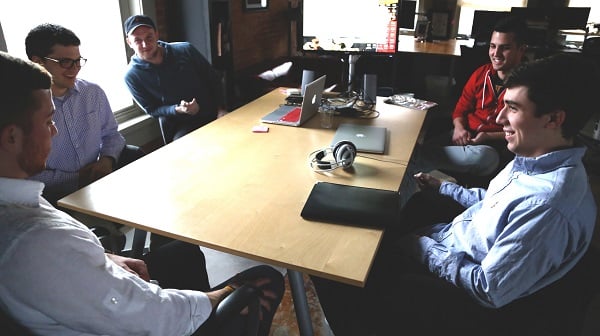Published on
Normalizing Certificates and Certifications for Today’s Learners

Today’s students have high expectations from their postsecondary experience, especially when it comes to outcomes. For the most part, learners are looking to complete their education and gain the basis for a high-paying job that leads to a career. This is especially true at America’s community colleges. However, the focus of many two-year institutions remains on degree completion and transfer—as does that of state lawmakers—even though that pathway doesn’t always fit with the goals of learners themselves. In this interview, Monty Sullivan shares his thoughts on the importance of non-degree certificate and certification programs for students.
The EvoLLLution (Evo): Why are certificates valuable and viable options for today’s students?
Monty Sullivan (MS): The value of alternative options doesn’t begin with the certificates or with the credential itself, but with the population and the desires of the population. More and more, we’re seeing an older student population.
In this country, we have a notion that higher education is strictly sequential from secondary education, so we believe our student population must be 18 to 24 years old. In reality, however, the data shows us very clearly that a large portion of the American higher education population are of non-traditional age. This is particularly true in America’s community colleges; in Louisiana, our average student’s age is 27.5 years old.
As you think about that non-traditional population, these are people who very likely have been in the labor force for many years. They have worked in what you may think of as low-wage jobs, they have struggled through life. They’ve been to what we might refer to as the School of Hard Knocks and, as they think about their life position and begin to re-evaluate where they would like to be, they become very focused on gaining the skills they know will take them to a different place. As a result of that, certificates and credentials become extraordinarily important.
I view our institutions as being responsive to markets, and that means responsive to the needs of our student population as well as responsive to the needs of industry. We are the connector between those two groups and, in my view, there is an economic imperative driving people to pursue alternative credentials.
Evo: What are some of the key differences in the expectations of the non-traditional student that today’s institutions really need to start adapting to?
MS: I believe that our universities were created as places where a select few had the opportunity to participate in higher education. Over time, our postsecondary environment has grown into a much more democratic system where higher education has become more available through universities to much of the population.
As American community colleges developed, however, we have seen a “follow on” phenomenon take place where two-year colleges are developing themselves to look more like universities. The challenge is that the mission of community colleges is different than that of universities. At many of our universities, much of the appeal and the attraction is the beautiful buildings, the gorgeous campuses and the social aspects of campus. The really great academic programs and faculty they offer tend to come second. Now we’re beginning to see community colleges follow that model, but our focus should be all about the program.
The primary reason for that is, at community colleges, we’re serving people who have been through the School of Hard Knocks and that population has such a small cushion in life. There is no savings account, there is no opportunity for failure. They have to find the shortest distance between where they are and a credential that gets them to a well-paying job to support their families. I often ask our college presidents to go to their own college websites and do a very simple search: I want them to identify how many programs their institution offers that will get a student to a $15/hr job in 26 weeks. Why is 26 weeks important? Because that’s how long unemployment benefits last.
There’s a very significant difference between the target audiences of a community college and a traditional university. A traditional university is geared toward the 18-year-old that mom and dad have sent off to college, and they put together great financial aid packages for them to support this kid toward a bachelor’s degree. At the community college, we’re trying to meet the needs of the 27-year-old single mother of two who’s struggling along, trying to work a job on the side, take care of kids and balance daycare. They want to make sure everything they’re spending their time on in the college has value for employers. They look right past the institution to the employer and ask themselves whether they’re en route to earning a credential that will get them a $15/hour job. This is the mindset of the postsecondary education consumer and, frankly, it’s not the mindset of two- or four-year institutions. Today’s students have a consumer mindset—they know what they’re looking for and they’re going to go to the institution that offers it.
Evo: Why is the debate around the value of sub-degree credentials still ongoing?
MS: The debate around the value of these credentials boils down to a discussion around traditional versus progressive higher education.
On one side of the argument, you have folks who are being responsive to what the market wants—to both student demand and employer demand. On the other side, you have folks who are more traditional in their beliefs about higher education and see market responsiveness as a fad.
I think economic forces will prove the traditionalists wrong over time. Certainly, there will always be value in degree programs, and there will always be value in liberal arts. In fact, liberal arts programming directly responds to the needs of employers who want employees who can think critically. However, we need to make sure we’re addressing the needs of all our prospective students.
This debate is more about our willingness and ability to accomplish change and to be responsive to markets. Really, the traditional mindset of the institution is faculty-centric, but today’s learners want an institution that is student-centric. Students are looking outside the institution to determine what it is they should learn as opposed to relying on the all-knowing faculty.
Evo: Do students need to be convinced of the value of pursuing certificates and certifications as well as—or maybe instead of—traditional degrees?
MS: I would not frame it as a binary; instead of thinking of it as certificate versus degree, I would think of it as certificate and then degree. Very few people fully understand the long-term implications of a certificate, though the long-term value of a degree is widely known.
We’ve talked a lot about getting students to jobs that pay $15/hour. However, that wage is not going to get a single mother with two kids to a place of comfort. Once students are in that first well-paying, secure job, they start to look around and figure out what’s next. As such, this conversation around credentials becomes much more of a career pathway discussion.
We have seen a fundamental shift in how we understand higher education—we used to believe higher education was a one-shot deal, but today postsecondary education is more iterative than ever before. Students are entering institutions, earning credentials, working, coming back to the institutions, earning another credential and then going back to work. This iterative approach to higher education is why I don’t think it’s necessarily a binary between certificates and degrees. We’re already starting to see a shift in the pattern of when and how students enroll in postsecondary education, and in their flow from that first enrollment through their academic career.
Evo: Do you want to see community colleges moving more aggressively towards the stackable model?
MS: There’s no question that community colleges should be working towards building more stackable options. The stackable model isn’t necessarily limited to technical education—you could have a stackable approach to things like transfers. In fact, many states have this mechanism in place with a basic two-year credential that tells a university that a transferring student has accomplished the general education core for the freshmen and sophomore years at the university.
A movement towards clear, stackable pathways is something that will fundamentally change how our institutions are thinking about the success of our students.
Evo: What needs to change in order for us to get to this reality this market?
MS: Adjusting to this new demand and these new, consumer-minded students requires a fundamental shift in our institutions overall.
It really begins with a fundamental shift in how we think of how our students arrive at our doors. We’re currently in orientation season, where students are showing up on campuses nationwide to be oriented. This is a time when we anticipate 18-year-old kids who just graduated from high school showing up on college campuses, and the orientation process is designed for—and probably works for—those traditional students. But for the non-traditional student, they’re thinking about having to give up a day of work, pay for child care and find transportation to participate in the orientation. They have a completely different set of concerns and their needs from the orientation process differs completely. The fundamental challenge here is that our institutions need to become more aware of the population that we’re serving. The external perspective from employers is that higher education institutions need to be working to close the skills gap. If you look at the number of kids graduating high school every year, there’s no way that educating every high school graduate is ever going to close that skills gap. On the other end, the population of adults without a college credential is massive. To use Louisiana as an example, we have about 40,000 kids who graduate high school each year. On the other hand, we have 1.65 million adults with no college credential. You tell me which group we should target. For us to close the skills gap demands a fundamental change in our perspective.
We also need to make sure the programs and courses we teach are aligned with market demands. This begins with a data analysis of what jobs are available, what jobs are well-paying or family-sustaining jobs, and then understanding what education those jobs require and offering those programs. We can no longer afford to simply offer everything to every student—we also can no longer afford to be institutions where students show up and find themselves. We have to be the institutions where students know whatever program they enroll in is a program that’s either going to help them transfer successfully or help them get a well-paying job. To that end, we can no longer afford to offer programs that result in dead-end jobs.
Bringing this all together, it’s critical that we get students the credentials and the skills they need as quickly as we can. The likelihood is that most of these folks do not have two to four years to finish their associate’s degree programs. So how do we shorten that time frame for those students?
Every aspect of who we serve, what we deliver and how we deliver it needs to be reconsidered and that extends well beyond the two-year college ranks. It is a call for us in higher education to think differently and to deliver a product that is more in line with the needs of the market.
Evo: What are some of the long-term benefits of shifting to a more market-responsive model?
MS: We’ve become far more savvy on the business side in Louisiana due to unfortunate circumstances with state funding. We’ve gone from a system whose budget is 70 percent state funds and 30 percent tuition funds, and we’ve flipped to a 30:70 ratio the other way. Unfortunately, as state funding declines, student tuition goes up. We have become much more oriented towards the needs of the consumer because the consumer is much more important in this equation from a business perspective.
We want to ensure that that student has a really good experience because, if indeed the premise is correct, that student will return our institution because of an iterative higher education process. We need to make sure that the student has a great experience the first time at the college. This means we need to be perfect in student services, enrollment processes, financial aid all the way through to completion. We need to ensure that, upon completing, they will find a pathway to a well-paying job. Ultimately, if we do all this and deliver a great experience, they will return.
While we originally thought of the business side of higher education from an enrollment funnel perspective, we need to understand that there is so much more—it is relevant across the entire lifecycle. Students don’t just look at what kind of experience they had in the enrollment process, but also they look at the results of their higher education investment. They look at whether they achieved what they were hoping to achieve. If they did, then they come back for the next credential or the next improvement in their life circumstance.
Evo: Is there anything you’d like to add about the importance of alternative credentials for todays students and almost the irrelevance of the debate around whether a degree or credential or certificate is more valuable?
MS: As a starting point, it is extraordinarily important that we continue to have this discussion beyond the limited context of institutions and our academic credentials. Instead, we need to talk about these issues in the context of the individual who’s trying to improve their life circumstance. If we can start looking at major higher education issues from the perspective of our students and their aspirations—as well as from the perspective of our industry partners—we as higher education leaders will be better served.
Secondly, this is not an easy set of changes for us to make in higher education. By no means am I suggesting that Louisiana colleges and universities, or community colleges in general, have figured this out in large numbers. In fact—because of the financial strain that our institutions have been placed under here in Louisiana, and because of the extraordinary job demands that exist in some markets in Louisiana—we have been placed in what I really think of as a bit of a compression circumstance. That is to say, compression from a financial perspective and compression from a workforce demand perspective, which has caused us to have to think differently about some of these core issues. It has been painful at times, but we’ve benefitted from this change in perspective and the way forward for us in higher education is to embrace the change.
Oftentimes we talk about higher education as being a source of innovation and change for society. The most important innovation and change that higher education can embrace in the next decade is to begin to think of our institutions not as institutions that lag in change but as institutions that lead in change. Now there’s a stark difference between the change of an organization versus the innovation in science and technology that we’ve driven, but we have got to focus on the changes that institutions need to be making.
This interview was edited for length and clarity.



